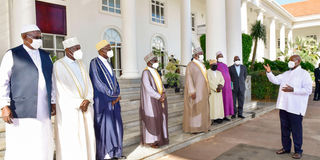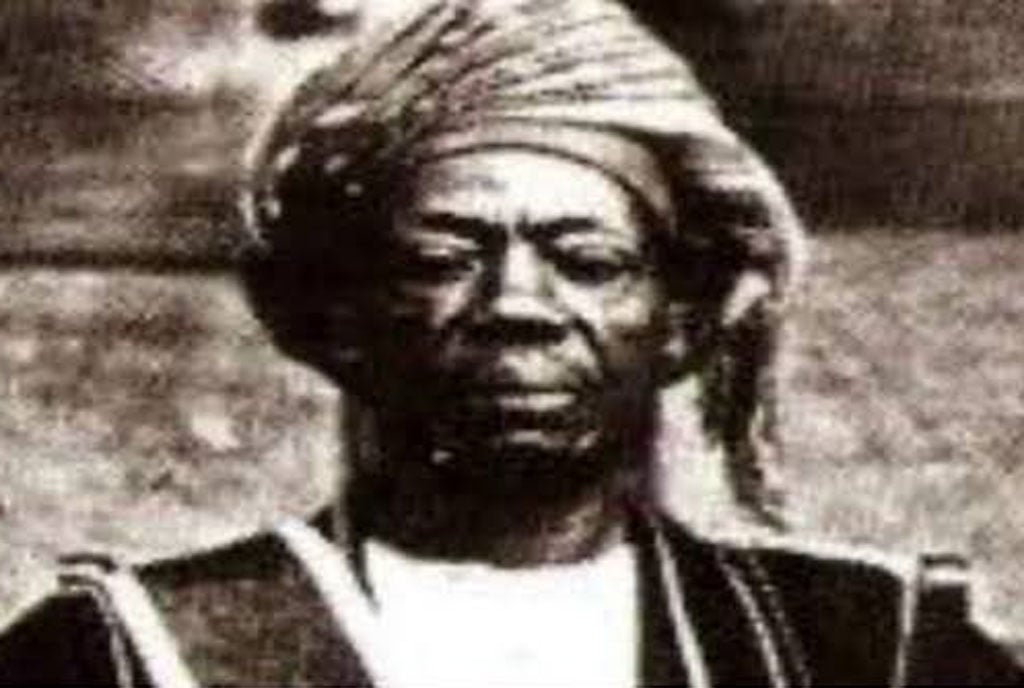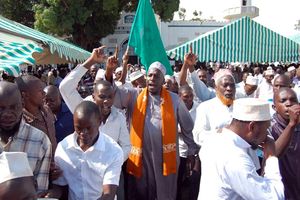
President Museveni (right) gestures as he addresses leaders of the different Muslim factions at State House, Entebbe on April 12, 2022. PHOTOS/ PPU
As contact between Europeans and the African continent increased throughout the 19th Century, they increasingly came into contact with African religions.
Brenda McCollum, in her doctorial research, notes that the religions, varying across the continent, cannot be discussed in depth. She, however, hastens to add that the reaction that missionaries, colonial officials, and European anthropologists had to these religions is pertinent to understanding how European imperialist powers developed their colonial states’ religious policies and how religion in Africa has subsequently been studied and misunderstood.
“Religion, across space and time, is both a reflection of the society which practices it and a tool which people use for a myriad of ends. In the 19th Century, Christianity in Europe became an institutionalised system through which common people sought eternal redemption and elites sought social and cultural influence in the here and now,” McCollum notes in her peer-reviewed article titled The Racialisation of Islam in Sub-Saharan Africa—A Study of the Kingdom of Buganda.
“Many Europeans were devoted to their religions on a spiritual level, however, in the upper echelons of society in Europe, religion was also an avenue for societal advancement, despite the fact that the continent was moving towards political secularisation in the 19th Century. On the African continent, religion played a much different role. Generally, religion across Sub-Saharan Africa permeated every aspect of one’s life,” she adds in her body of work published in the Arc: Journal of the School of Religious Studies.
McCollum reveals: “Africans believed that their livelihood, political leadership, economy, military success, and overall communal and societal wellbeing were all affected in very direct ways by religious practice. The 19th Century Christian definition of religion was simply not compatible with the African reality of religious practice. This was especially true as European states and political systems were becoming increasingly secularised. However, despite this, European missionaries, colonial officials, and anthropologists used their understanding of religion to judge and then primitivise African religious practices.”
McCollum says examples of this devaluation can be seen across the African continent. “Missionaries openly disrespected African religious beliefs, colonial policies gave an unfair advantage to those who converted to Christianity, and land policies, such as the Mailo system in Uganda, prohibited Africans from practicing many of their spiritual and cultural traditions and rituals. At the same time, the first in-depth studies of African religion were being undertaken by European missionaries, colonial officials, and anthropologists. These 19th and early 20th century accounts, though often valuable due to their level of detail, are extremely racially biased and tend to cast Africans as inherently unintelligent, uncivilised, and incapable.”
“Some accounts, such as John Roscoe’s, are admirable for the level of respect and genuine fascination they show towards African cultures and societies, but accounts such as these are the exception, rather than the norm. It was from these biased accounts that Europeans, and much of the wider world, formed their ideas regarding religion in Sub-Saharan Africa. The presentation of African religion in these studies, and the common biases of the 19th to the 20th centuries, caused those in the West to view religion in Africa as backward, underdeveloped, idolatrous, and heathenistic,” she adds.
McCollum reasons that the biases were for the most part “due to the cultural superiority Europeans assumed for themselves over Africans.” She also proffers that the aforesaid biases “can be seen as a further example of politically motivated ‘othering’ of peoples and cultures different from one’s own.”
Islam noir
One of the things ‘othered’ was Islam noir. It is the ideology that Islam practiced by Africans south of the Sahara is inherently inferior to the Islam practiced in North Africa and the Middle East. Islam noir, beginning as a French colonial ideology, affected how all European powers interacted with Muslims and Islam in their sub-Saharan African colonies in the 19th to 20th centuries, per McCollum.
In addition to the discriminating view of African Muslims that this doctrine espoused, it also led European powers to actively marginalise Islam within their colonies. This ranged from limiting the autonomy of Muslim leaders to underfunding Muslim education. All this, McCollum adds, was intended to suppress Muslims’ ability to communicate with the wider Muslim world.
The marginalisation of sub-Saharan African Muslims took place within the context of global colonialism in the 19th and 20th centuries. In Muslim-majority areas, Muslims held social and political power, meaning they were still able to demand certain levels of respect from their colonial states. However, in Muslim minority areas such as Buganda, Muslims held no such influence and were left to survive largely on their own in racially and religiously biased colonial states, McCollum further discloses.
In her conclusion, McCollum writes: “Since the first known contacts between Europe and what would be the Muslim world, Europeans have overtly racialised and demonised this non-Christian community. Even over centuries of engagement with the Muslim world, during the medieval era, Europeans remained distrustful of Islam and Muslims more generally. In the 19th Century, as Europeans encountered Islam in sub-Saharan Africa, they found an Islamic tradition different from what they had previously interacted with. Keeping with their historic attitudes, imperial powers racialised and sought to delegitimate the Islam they encountered in sub-Saharan Africa.”
“This racialisation was then mirrored, to a large extent, by the anthropologists and historians who studied sub-Saharan Islam in the late 19th and 20th centuries. This racialisation, by the colonial state and Western scholarship, affected the lives of Muslims and how those in the West perceived Islam and Muslims on the African continent. All of this has culminated in a lack of understanding of Muslim history in sub-Saharan Africa and a negative perception of sub-Saharan Islam.”
Historians like Ware, Kodesh, and Konadu are specifically commended for “working to dismantle these negative perceptions of African Islam and are seeking to understand and study African religion through a less Western epistemology.” McCollum, nevertheless, is not in doubt that there’s work to be done insofar as “recontextualis[ing] Islam in Africa and gain[ing] a more holistic understanding of Muslims in sub-Saharan Africa” is concerned.
Attempts at reconciliation
“As the Muslims, from the 1920s, became more eager to master the intricacies of their faith, they ended up being divided on minor theological issues,” Isaac Ssettuba, a translator/interpreter/researcher, says. “Three of these stood out: the permissibility of offering both the weekly Friday prayer ‘Juma/Jumuah’ and the daily midday prayer ‘Zukuli/Dhuhr’ consecutively; the determination of commencement and end of Ramadhan using calendar or relying on actual moon-sighting, and the playing of Tambourines (Mataali) during religious gatherings.”
Ssettuba adds that, before the 1943 Makka consultations, there had been attempts to reconcile Muslims on such issues, with the involvement of the Buganda Kingdom and the colonial administration. In 1923, Kabaka (king) Chwa and some great chiefs pulled out of mediation over complaints that they were not competent enough to judge Islamic matters. In 1927, the Muslims, with approval of kingdom and colonialists, invited a Zanzibari Kadhi (high judge) to clarify on the ‘Juma-Zukuli’ matter. And in 1943, a delegation of prominent Ugandan sheikhs, including among others Muhammad Lubowa, Swaibu Ssemakula and Abdullah Sekimanyi, performed the Hajj, and took the opportunity to put the same issue to a Makka Mufti (authority on religion).
“The clarifications of the consulted external authorities showed that the ‘Juma-Zukuli’ matter was a minor one that should not divide Muslims. Either group had ground for defence. On the one hand, a mosque with some 40 Muslim residents attending a ‘Juma’ prayer was better placed to offer ‘Juma only.’ On the other hand, for mosques hosting mainly visiting Muslim worshipers, without the 40 resident devotees, offering of ‘Juma’ and ‘Zukuli’ consecutively was permissible and advisable,” discloses Ssettuba, a praticising Muslim.
He adds: “Personally, Sheikh Ssekimwanyi A had parted ways with Kibuli in the early to mid-20s, when he was not elected head ‘Muwalimu/Mualim’ to Mbogo’s successor Prince Badru Kakungulu (1907-1991). He was leader of a ‘Juma alone’ breakaway group based at Bukoto.”
Elsewhere, “Kakungulu’s declaring Kibuli a ‘Juma only’ Mosque in 1947 marked”, per Ssettuba, “the acceptance of the reconciliatory Makka ruling in the ‘Juma-Zukuli’ matter. It also signalled, he further opined, “maturity of the local Muslim community in appreciating the inevitability of divergence in religious doctrinal interpretation.”
“‘Juma only’ became the widespread practice for most Uganda Muslims, who were beginning to show tolerance in their religious practice. Perhaps, in a way, embracing ‘The Prince’s choice’ meant adherence to a Ganda mainstream ‘Islamic obedience,’ Ssettuba says, adding: “Nonetheless, marginal Islamic religious groups were well alive, and they went on to build ‘identity’ around ‘the minor doctrinal differences.’”
Sheikh Abdurahman Mivule of Kawempe kept his ‘Juma-Zukuli (Sect)’ alive. Another noticeable group named after its Sheikh, was the Mugenyasooka/Mugenyi Asooka (Sect) of Nateete, who prayed ‘Juma only’, rejected ‘Mataali’ at religious gatherings and stuck to the use of a calendar for the Ramadhan.
Muslims martyrs
Ssettuba says the 70 Muslims who Kabaka King Muteesa I killed were part of the larger group of ‘followers of foreign faiths,’ whom he accused of disrespect and collaboration with foreign enemies.
“The noted Muslim martyrs were killed on orders of King Muteesa I around 1875. The Ganda monarch had actually learnt and practiced Islam between 1860 and 1875, with fair commitment. And, thereafter, until Mwanga’s death in 1884, he did so halfheartedly, given his ‘conversion’ to Christianity and occasional return to his traditional religion,” Ssettuba says.
“King Muteesa pre-1875 Islam was under instruction of Arab and Swahili (sheikhs) from Zanzibar, who were more of traders than holy men. Thus they were rather lax about some Islamic exigencies like circumcision, direction of Makka (Qiblah, where Muslims face when in prayer) and (possibly consumption of alcohol),” he adds.
Ssettuba says the arrival of mainly Muslim Egyptian soldiers (Baturuki), in the service of the khedive, who wished to extend his dominion southwards, “led to the correction of some aspects of ‘a faulty Islam’ that was being practiced in Buganda.” The sheikhs in ranks of the Baturuki pointed out the errors to the coastal coreligionists and the new Ganda converts, many of whom were pages at the king’s court, Ssettuba further reveals.
“Muteesa was not circumcised and the palace mosque where he used to lead prayer was facing the wrong direction. Some 70 zealous Muslim converts paid with dear life for refusing to pray behind an uncircumcised ‘Imam’, let alone eating meat slaughtered by his hand,” he adds.
In the 19th Century, as Europeans encountered Islam in Sub-Saharan Africa, they found an Islamic tradition different from what they had previously interacted with. Keeping with their historic attitudes, imperial powers racialised and sought to delegitimate the Islam they encountered in Sub-Saharan Africa,” Brenda McCollum, lecturer in African Studies at the University of Oxford in England.
Division among Muslims
After Prince Nuhu Mbogo Kyabasinga’s death in 1921, there was an exclusion of non-members from Kibuli. Ssettuba opines that the exclusion “was meant to preserve the faction’s identity and political clout.” The Kibuli Sheikhs were rallying around ‘a prince’, he notes “implying support to the monarchy, and their positions were also gaining relevance internally and outside the country.”
Ssettuba singles out politics, religious doctrine, and foreign influence as main causes of division among the Muslim of Uganda. On politics, he said: “As far back as the late 1880, Muslims constituted a politico-religious party that ended up internally divided for lack of harmony, some preferring rebellion and other collaboration with powers that be. After independence, the State tended to divide Muslims further. For example, the founding of the National Association for the Advancement of Muslims (NAAM) in 1965 under the Uganda Peoples Congress (UPC) patronage, hindered Muslims from taking common positions on matters affecting them.”
Ssettuba also notes that “aspects of Islamic religious doctrine with the corresponding practices were interpreted differently by the various sections of Ugandan Muslims.” He adds that ruptures arising out of interpretations around ‘Juma-Zukuli’ and ‘Mugenyasooka’ serve to illustrate this point. According to him, “Islam is foreign to Uganda, and, in the case of Buganda, it has conflicted with local traditional norms.” This has teased out divisions around how to relate to the new faith.
“Islam is also differently practiced in its ‘lands of origin,’ with the differences infiltrating and dividing the recipient communities. Remember the re-reading of the nascent coastal inspired Islam by the Egyptian, which led to martyrdom. The Tabligh movement in Uganda that has divided Muslims into adepts of ‘traditional’ and ‘revolutionary’ tendencies in religious practice, is a result of wholesome adoption of literalism of Saudi Wahhabism,” he says
He concludes: “External hands also contribute to social divisions within the Muslim community. Foreign educated sheikhs tend to promote the brand of Islam of their country of training. And where the country offers financial support, the sheikhs may implicitly or explicitly promote the country’s socio-religious agenda, with political implication in some instances. The activities of Libya’s Islamic Call Society and Saudi Arabia’s World Muslim League in Uganda are fair illustrations.”




